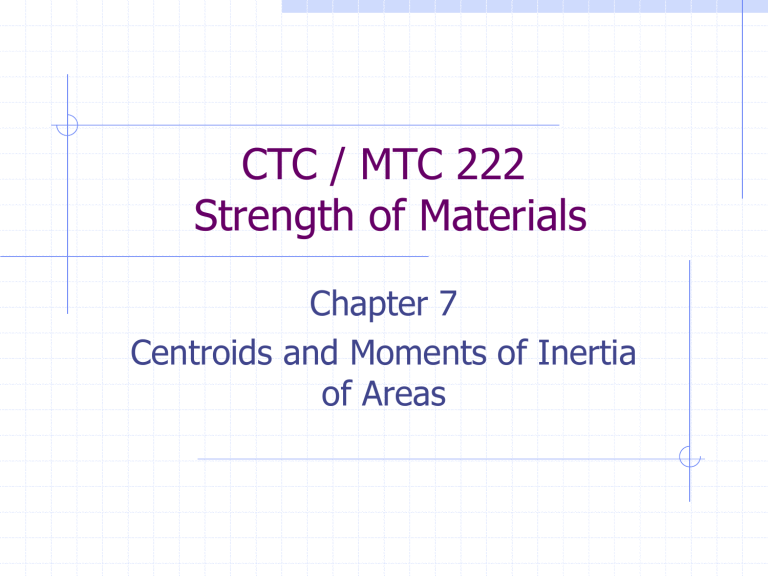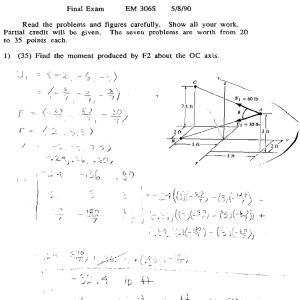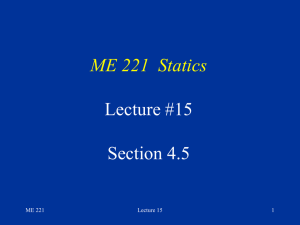
CTC / MTC 222 Strength of Materials Chapter 7 Centroids and Moments of Inertia of Areas Chapter Objectives • Define centroid and locate the centroid of a shape by inspection or calculation • Define moment of inertia and compute its values with respect to the centroidal axes of the area • Use the parallel axis theorem to compute the moment of inertia of composite shapes Centroid of an Area • Centroid of an area – the geometric center of the area • Centroid of simple shapes – circle, rectangle, triangle • • Often, easily visualized Centroids and other properties shown in Appendix A-1 • Centroid of complex shapes with axes of symmetry • • • If area has an axis of symmetry – centroid is on that axis If area has two axes of symmetry – centroid is at the intersection of the two axes Centroid of complex shapes without axes of symmetry • • Can often be considered as a composite of two or more simple shapes Centroid of complex shape can be calculated using centroids of the simple shapes and the locations of these centroids with respect to some reference axis Centroid of an Area • Centroid of complex shapes can be calculated using: • AT ̅Y̅ ̅ = ∑ (Ai yi ) where: • AT = total area of composite shape • ̅Y̅ = distance to centroid of composite shape from some reference axis • Ai = area of one component part of shape • yi = distance to centroid of the component part from the reference axis • Solve for ̅Y̅ = ∑ (Ai yi ) / AT • Perform calculation in tabular form • See Examples 7-1 & 7-2 Moment of Inertia • Moment of Inertia - a measure of the stiffness of a beam, or of its resistance to deflection due to bending • Sometimes referred to as the second moment of area, or the area moment of inertia • Moment of inertia of an area with respect to a particular axis – the sum of the products of each (infinitesimal) element of the area by the square of its distance from the axis • Approximately – I = ∑ y2 (∆A) Exactly - I = ∫ y2 dA • Formulas derived from basic definition, shown in Appendix A-1 • • Moment of inertia of simple shapes – circle, rectangle, triangle • Moment of inertia standard structural shapes – wide flange sections, channels, angles, pipe, etc. • • Tabulated in standard references such as Steel Design Manual Some in Appendix A Moment of Inertia Moment of inertia complex shapes • • Can often be considered as a composite of two or more simple shapes If all component parts have the same centroidal axis • Add or subtract the moments of inertia of the component parts with respect to the centroidal axis • If all component parts do not have the same centroidal axis • Moment of inertia can be calculated using the parallel axis theorem • Parallel axis theorem • Moment of inertia of a shape with respect to a given axis is equal to the sum if the moment of inertia of the shape to its own centroidal axis plus the transfer term, Ad2, where A is the area of the shape and d is the distance from the centroidal axis to the axis of interest • I = I0 + Ad2 Moment of Inertia of Composite Shapes • Perform calculation in tabular form • • • • • • • • Divide the shape into component parts which are simple shapes Locate the centroid of each component part, yi from some reference axis Calculate the centroid of the composite section, ̅Y̅ from some reference axis Compute the moment of inertia of each part with respect to its own centroidal axis, Ii Compute the distance, di = ̅Y̅ - yi of the centroid of each part from the overall centroid Compute the transfer term Ai di2 for each part The overall moment of inertia IT , is then: • IT = ∑ (Ii + Ai di2) See Examples 7-5 through 7-7 Radius of Gyration, r • Radius of Gyration - a measure of a compression member’s slenderness, or its resistance to buckling due to compressive load • • Buckling – Failure under compressive load by excessive lateral deflection at a stress below the yield stress (elastic buckling) Buckling will occur about the axis with the least radius of gyration • The tendency for a compression member to buckle is directly proportional to its length squared and indirectly proportional to its radius of gyration squared. • Radius of Gyration r = √ (I /A )


